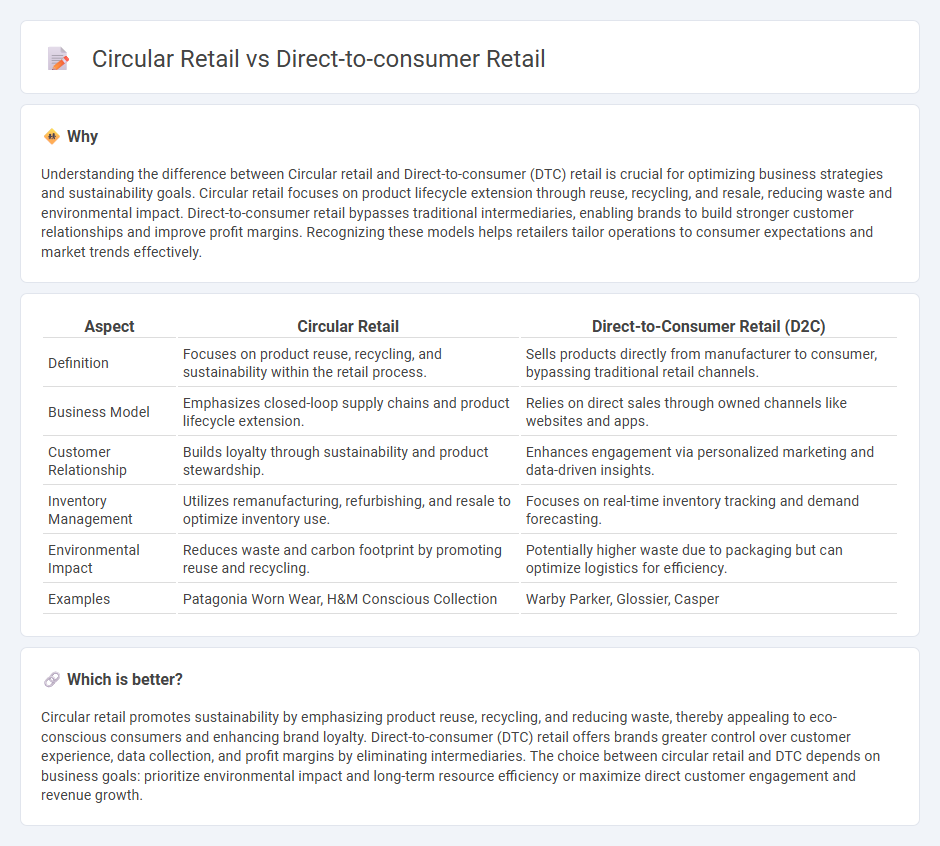
Circular retail focuses on sustainable practices by promoting product reuse, recycling, and resale, thereby reducing environmental impact and fostering a circular economy. Direct-to-consumer (DTC) retail emphasizes bypassing traditional intermediaries, enabling brands to sell directly to customers through online platforms, enhancing customer relationships and data insights. Explore the differences and advantages of circular retail versus direct-to-consumer strategies to optimize your business model.
Why it is important
Understanding the difference between Circular retail and Direct-to-consumer (DTC) retail is crucial for optimizing business strategies and sustainability goals. Circular retail focuses on product lifecycle extension through reuse, recycling, and resale, reducing waste and environmental impact. Direct-to-consumer retail bypasses traditional intermediaries, enabling brands to build stronger customer relationships and improve profit margins. Recognizing these models helps retailers tailor operations to consumer expectations and market trends effectively.
Comparison Table
| Aspect | Circular Retail | Direct-to-Consumer Retail (D2C) |
|---|---|---|
| Definition | Focuses on product reuse, recycling, and sustainability within the retail process. | Sells products directly from manufacturer to consumer, bypassing traditional retail channels. |
| Business Model | Emphasizes closed-loop supply chains and product lifecycle extension. | Relies on direct sales through owned channels like websites and apps. |
| Customer Relationship | Builds loyalty through sustainability and product stewardship. | Enhances engagement via personalized marketing and data-driven insights. |
| Inventory Management | Utilizes remanufacturing, refurbishing, and resale to optimize inventory use. | Focuses on real-time inventory tracking and demand forecasting. |
| Environmental Impact | Reduces waste and carbon footprint by promoting reuse and recycling. | Potentially higher waste due to packaging but can optimize logistics for efficiency. |
| Examples | Patagonia Worn Wear, H&M Conscious Collection | Warby Parker, Glossier, Casper |
Which is better?
Circular retail promotes sustainability by emphasizing product reuse, recycling, and reducing waste, thereby appealing to eco-conscious consumers and enhancing brand loyalty. Direct-to-consumer (DTC) retail offers brands greater control over customer experience, data collection, and profit margins by eliminating intermediaries. The choice between circular retail and DTC depends on business goals: prioritize environmental impact and long-term resource efficiency or maximize direct customer engagement and revenue growth.
Connection
Circular retail and direct-to-consumer (DTC) retail converge through their shared emphasis on sustainability and customer engagement. Circular retail prioritizes product lifecycle extension via reuse, recycling, and resale, while DTC retail facilitates direct customer interactions, enabling transparent communication about sustainable practices. Combining these models supports eco-friendly consumption by minimizing waste and fostering brand loyalty through personalized experiences.
Key Terms
Source and External Links
Direct-to-consumer - Wikipedia - Direct-to-consumer (DTC) is a business model where products are sold directly to customers, bypassing third-party retailers, wholesalers, or middlemen, typically through e-commerce platforms but sometimes complemented by physical stores.
What Is Direct-to-Consumer? Everything You Need To Know (2024) - DTC allows brands to sell straight to consumers via their own digital channels, giving them full control over customer experience, data collection, and branding without relying on intermediaries.
The Ultimate Guide to Direct To Consumer (DTC) - The DTC approach lets manufacturers or consumer brands control the entire customer journey by eliminating traditional wholesale and retail distribution networks, leveraging e-commerce for direct access to end users.
 dowidth.com
dowidth.com